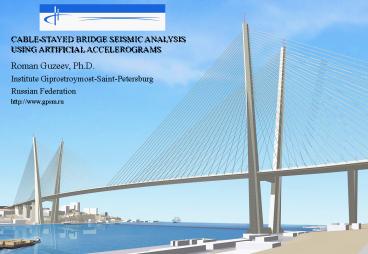Application of parameterized analytical models - PowerPoint PPT Presentation
1 / 27
Title:
Application of parameterized analytical models
Description:
it is inapplicable for structures with anti-seismic devices, which make behavior ... It considers mode shape vibration as statistically independent ... – PowerPoint PPT presentation
Number of Views:82
Avg rating:3.0/5.0
Title: Application of parameterized analytical models
1
CABLE-STAYED BRIDGE SEISMIC ANALYSIS USING
ARTIFICIAL ACCELEROGRAMS Roman Guzeev,
Ph.D. Institute Giprostroymost-Saint-Petersburg Ru
ssian Federation http//www.gpsm.ru
2
1
The Eastern Bosporus bridge, Vladivostok, Russia
3
2
Presentation of the Response spectrum in national
codes
4
3
Disadvantages of the Response Spectrum Method
- it is inapplicable for structures with
anti-seismic devices, which make behavior of the
structures nonlinear - It does not take into account seismic wave
propagation - It considers mode shape vibration as
statistically independent - It uses approximate relations between response
spectrum curves with different damping.
5
4
Time history analysis using accelerograms.
Instrumentally recorded ground acceleration.
1994, Northridge, Santa Monica, City Hall Grounds
1940, El Centro Site
6
5
Instrumentally recorded ground acceleration ?
- The main features
- Instrumentally recorded earthquake acceleration
is an event of random process - Every earthquake is unique and has its own peak
acceleration and spectral distribution - Any earthquake Depends on ground condition
- Instrumentally recorded acceleration can be
dangerous to one type of structure and can be
safe to another
7
6
Artificial accelerograms
- Artificial accelerogram should meet requirements
of national codes - There should be a peak value on accelerogram. The
peak value depends on the region seismic
activity, ground condition and period of
exceedance. - 2. Accelerogram response spectrum should match
design spectrum
8
7
Artificial accelerograms
- Artificial accelerogram should meet physical
requirements - Acceleration, velocity and displacement should be
equal to zero at the beginning and at the end of
the earthquake - 2. Duration of the earthquake should not be less
than 10 sec.
9
8
The accelerogram generation algorithm
Step 1. Generating accelerogram with peak
value equal to 1 Step 2. Scaling
accelerogram according to the design value
of ground acceleration.
The accelerogram to be found is presented as
trigonometric series
We take into account the modes which contribute
to effective modal mass in the earthquake
direction
10
9
The accelerogram constraints
Peak value nonlinear constraint
Acceleration, velocity and displacement linear
constraints
11
10
Generated accelerogram response spectrum
Where,
is the solution of differential equation of
motion for one DOF oscillator on sine and cosine
base excitation.
- damping ratio of design response spectrum
12
11
The coefficient of series terms to be found ?an
be determined by means of the least square method
with linear and nonlinear constraints We minimize
the sum square of differences between
accelerogram response spectrum and the design
response spectrum
F object sum square function W diagonal
matrix of weight factors
vector of differences between the
accelerogram response spectrum and the design
response spectrum
13
12
- Recommendation on analysis using artificial
acelerogram - Terms of series should contain natural
frequencies of structures. It lead to resonance
excitation. - We should take into account the modes which
contribute to effective modal mass in the
earthquake direction - For the closest match to design response spectrum
we can add extra terms into the series - We have to generate more than one design
accelerogram. We can do it by varying the number
of terms and considered modes - For every strain-stress state parameter we have
to built an envelope caused by action generated
accelerograms
14
13
Golden Horn Bay cable-stayed bridge, Vladivostok,
Russia
Concrete deck
Steel deck
15
14
Seismic action input data
Elastic response spectrum
- design spectrum
- elastic spectrum
- ductility factor
- elastic spectrum
Peak ground acceleration
with 0.08 damping ratio
Return period is 5000 years.
- dumping correction factor
- modal damping ratio
16
15
GTSTRUDL Model
17
16
18
17
19
18
Stiffness weighted average damping
CONSTANT
MODAL DAMPING
PROPORTIONAL TO STIFFNESS 0.025 GROUP
'PYLON' MODAL DAMPING PROPORTIONAL TO STIFFNESS
0.02 GROUP 'DECK' MODAL DAMPING PROPORTIONAL TO
STIFFNESS 0.05 GROUP 'SUPP' MODAL DAMPING
PROPORTIONAL TO STIFFNESS 0.00096 GROUP
'CABLE' DYNAMIC PARAMETERS RESPONSE DAMPING
STIFFNESS 1.0 END OF DYNAMIC PARAMETERS COMPUTE
MODAL DAMPING RATIOS AVERAGE
20
19
Accelerogram generation results
21
20
Response spectrum analysis. GTSTRUDL statement.
STORE RESPONSE SPECTRA ACCELERATION LINEAR vs -
NATURAL PERIOD LINEAR 'SEYSM DAMPING RATIO 0.02
FACTOR 0.26242
END OF
RESPONSE SPECTRA RESPONSE SPECTRA LOADING 'RSP'
'response' SUPPORT ACCELERATION TRANS X FILE
'SEYSM' END RESPONSE SPECTRUM LOAD LOAD LIST
'RSP' ACTIVE MODES ALL PERFORM MODE SUPERPOSITION
ANALYSIS COMPUTE RESPONSE SPECTRA FORCES MODAL
COMBINATION RMS MEM ALLCOMPUTE RESPONSE SPECTRA
DISPL MODAL COMBINATION RMS JOINTS ALL
22
21
Time history analysis. GTSTRUDL statement.
STORE TIME HISTORY ACCELERATION TRANSLATION
'EARTHQ' FACTOR 0.26231 0.0000000
0.0000000 -0.0441006 0.0100000 -0.0805970
0.0200000
TRANSIENT LOADING
1 SUPPORT ACCELERATION TRANSLATION X FILE
'EARTHQ' INTEGRATION FROM 0.0 TO 25.0 AT
0.01 ACTIVE MODES ALL DYNAMIC ANALYSIS MODAL
STORE TIME HISTORY ACCELERATION TRANSLATION
'EARTHQ' FACTOR 0.26231 0.0000000
0.0000000 -0.0441006 0.0100000 -0.0805970
0.0200000
TRANSIENT LOADING
1 SUPPORT ACCELERATION TRANSLATION X FILE
'EARTHQ' INTEGRATION FROM 0.0 TO 25.0 AT
0.01 ACTIVE MODES ALL DYNAMIC ANALYSIS MODAL
23
22
The time history analysis results
24
23
Time history analysis record
25
24
The Result comparison
26
25
Conclusion
- Time history analysis using artificial
accelerograms overcome weaknesses of the response
spectrum method - this analysis is applicable for structures with
anti-seismic devices, which make behavior of the
structures nonlinear - this analysis can take into account seismic wave
propagation - this analysis does not consider mode shape
vibration as statistically independent - this analysis uses exact methods of taking into
account structural damping. - 2. Time history analysis using artificial
acelerograms does not contradict with national
codes. - 3. Time history analysis using artificial
acelerograms usually gives higher value of
forces and displacements.
27
Thank you for your attention































